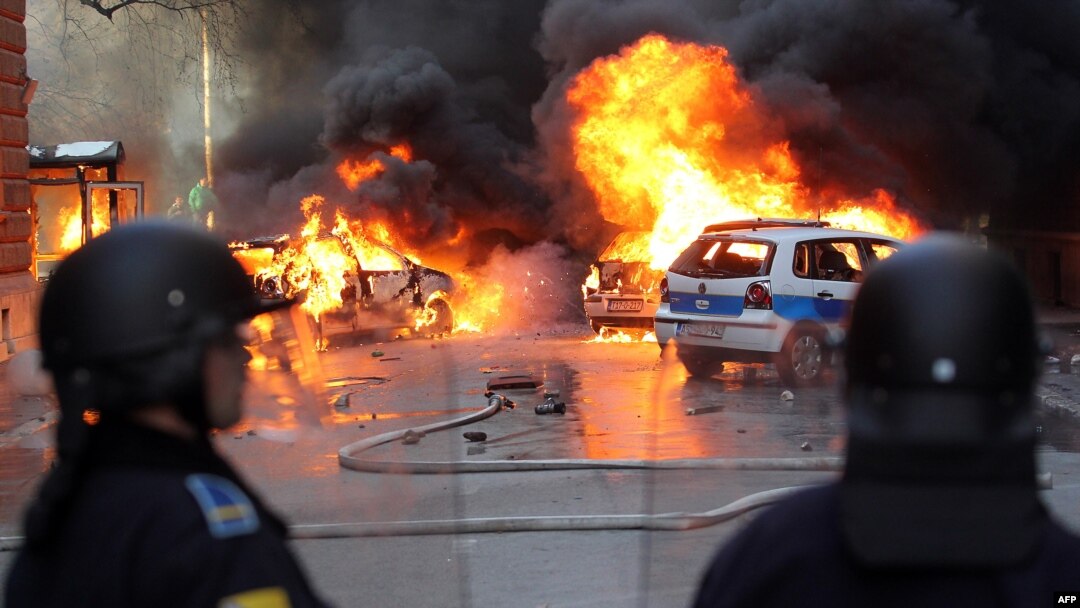Since the Dayton accords were signed in 1995, a fragile peace has existed in Bosnia-Herzegovina. But the unique system created by the accords has also created a mammoth bureaucracy that some blame for the recent unrest in the country.
Inspired by an online meme titled "Welcome to Bosnia," RFE/RL's Naida Skrbic takes a look at the numbers behind Bosnia-Herzegovina's labyrinthine bureaucracy and economic problems.
1 state
Bosnia-Herzegovina. The state, which declared its independence from the former Yugoslavia in 1992, descended into a devastating three-year war involving the three major ethnic groups (Bosniaks, Serbs, and Croats).
2 entities
The Muslim-Croat Federation consists mostly of Bosniaks (Bosnian Muslims) and Croats. Republika Srpska is dominated by Bosnian Serbs. There is also a small, self-governing administrative unit called Brcko District in the country's northeast.
5 presidents
At the state level, there is one president for each major ethnic group, with the chairmanship rotating every eight months. In addition, both the Muslim-Croat Federation and Republika Srpska elect presidents to lead their entities.
10 cantons
The Muslim-Croat Federation uses a federal system and is divided into 10 cantons. Republika Srpska has a centralized government.
127 registered political parties
The next general elections are due in October 2014.
136 ministries
Ministries exist at both the national and entity level.
422 euros
The average monthly wage (about $580), as of November 2013
551,456 registered unemployed
As of November 2013, the unemployment rate was 45 percent.
585,411 fewer people than in 1991
While many left during the Bosnian war, others have departed to find opportunity elsewhere.
566,025 people living in relative poverty
627,978 pensioners
In January 2014 the average monthly pension was 187 euros (around $250) in the Muslim-Croat Federation and 170 euros in Republika Srpska.
3,791,622 people
Just under two-thirds of the population, 2,371,603 people, live in the Muslim-Croat Federation; 1,326,991 live in Republika Srpska; and 93,028 live in Brcko District.
Inspired by an online meme titled "Welcome to Bosnia," RFE/RL's Naida Skrbic takes a look at the numbers behind Bosnia-Herzegovina's labyrinthine bureaucracy and economic problems.
1 state
Bosnia-Herzegovina. The state, which declared its independence from the former Yugoslavia in 1992, descended into a devastating three-year war involving the three major ethnic groups (Bosniaks, Serbs, and Croats).
2 entities
The Muslim-Croat Federation consists mostly of Bosniaks (Bosnian Muslims) and Croats. Republika Srpska is dominated by Bosnian Serbs. There is also a small, self-governing administrative unit called Brcko District in the country's northeast.
5 presidents
At the state level, there is one president for each major ethnic group, with the chairmanship rotating every eight months. In addition, both the Muslim-Croat Federation and Republika Srpska elect presidents to lead their entities.
10 cantons
The Muslim-Croat Federation uses a federal system and is divided into 10 cantons. Republika Srpska has a centralized government.
127 registered political parties
The next general elections are due in October 2014.
136 ministries
Ministries exist at both the national and entity level.
422 euros
The average monthly wage (about $580), as of November 2013
551,456 registered unemployed
As of November 2013, the unemployment rate was 45 percent.
585,411 fewer people than in 1991
While many left during the Bosnian war, others have departed to find opportunity elsewhere.
566,025 people living in relative poverty
627,978 pensioners
In January 2014 the average monthly pension was 187 euros (around $250) in the Muslim-Croat Federation and 170 euros in Republika Srpska.
3,791,622 people
Just under two-thirds of the population, 2,371,603 people, live in the Muslim-Croat Federation; 1,326,991 live in Republika Srpska; and 93,028 live in Brcko District.


